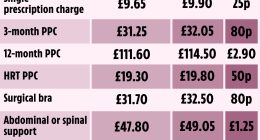WASHINGTON—State and local governments in early 2020 expected the pandemic-induced downturn to decimate their budgets, as millions of business closures and layoffs wiped out tax revenue.
In many places, the fiscal picture hasn’t been nearly as dire as feared.
A flood of federal aid for businesses and households helped prop up incomes and consumer spending. Unemployment fell and economic activity picked up much faster than expected. Unlike in previous recessions, equity and housing markets have done well.
SHARE YOUR THOUGHTS
Should the federal government provide aid to struggling states? Why or why not? Join the conversation below.
All of those factors bolstered state and local revenues last year. But pandemic-related costs have soared in many localities, resulting in budget holes that may force states to cut back on other services, lay off workers or raise taxes, absent more federal aid. Policy analysts estimate state and local revenue losses due to the coronavirus pandemic will total about $300 billion through fiscal year 2022, though that doesn’t include rising expenses.
State and local governments employ 18.6 million people, who provide services from collecting trash to teaching children. Democrats in Congress are pushing for $360 billion in aid to cities and states as part of President Biden’s $1.9 trillion coronavirus relief bill, while many Republicans argue that would only encourage fiscal profligacy.
Immediately after the coronavirus outbreak last March, states slashed revenue projections by an average of about 8%, with some expecting shortfalls as high as 20%. Those projections were largely based on experiences during the 2007-09 recession, when steep revenue declines lasted several years.
In the end, state revenues fell 1.6% in fiscal year 2020 and were 3.4% lower than projected before the pandemic, according to the National Association of State Budget Officers. While states expect revenues to decline 4.4% in fiscal 2021, which ends on June 30 for most, 18 states are seeing revenues come in above forecast.
States across the country have seen tax revenue sink during the pandemic, though revenues have held up better on average than initially feared.

Total tax revenue in March-November 2020, change from March-November 2019

Total tax revenue in March-November 2020, change from March-November 2019

Total tax revenue in March-November 2020,
change from March-November 2019

Total tax revenue in March-November 2020, change from March-November 2019
“The revenue problem hasn’t been nearly as bad as we thought,” said Michael Strain, the director of economic policy studies at the conservative American Enterprise Institute. “That’s good news.”
The bad news, according to Mr. Strain and others: a surge in spending on things like health care, jobless benefits and food assistance. Also, revenue losses vary significantly among states and cities.
“If you’re a state that’s doing worse, the fact that on average states seem to have held up pretty well doesn’t really matter to you,” Mr. Strain said.
State and local budget shortfalls have been at the center of discussions in Washington since last spring about what to include in another economic relief package.
Congress has provided state and local governments more than $300 billion in federal aid, including grants for education and higher federal matching funds for Medicaid, though the funds came with restrictions on how they could be spent. Now, some Republican lawmakers are proposing more money for schools and pandemic-related spending, such as vaccine distribution, but no funding specifically for state and local governments.
The left-leaning Center on Budget and Policy Priorities estimates the state and local revenue shortfall will total about $300 billion through 2022, as does Louise Sheiner, director of the Hutchins Center on Fiscal and Monetary Policy at the Brookings Institution. Moody’s Analytics puts the figure at about $330 billion, well below the $500 billion it estimated last spring.
State and local governments also have about $75 billion in rainy day funds to offset budget shortfalls. But analysts said it’s unclear how much expenses have risen due to the pandemic, making it difficult to estimate how much they may need.
Mr. Strain estimated $100 billion, in flexible funding, would be more than enough to help states get through the next fiscal year, which they must begin planning for now.
From last March, when a nationwide pandemic emergency was declared, through December, overall state revenues declined 1.8% from the same period a year earlier, according to data from Lucy Dadayan, senior research associate at the Urban Institute, a Washington think tank. Twenty states saw increases, including six—Vermont, Idaho, South Dakota, Utah, Colorado and Alabama—that saw revenues rise more than 3%. California, whose revenues held steady, projects a budget surplus for this fiscal year.
By contrast, 26 states reported revenue declines in the first 10 months of the pandemic, including nine where revenues dropped more than 5%. Five states—Alaska, Florida, Hawaii, North Dakota and Oregon—experienced double-digit declines.
Most states were in a strong fiscal position heading into the pandemic, with a high share of reserves relative to general expenditures.

Total balances in fiscal year 2019, as a percentage of general fund expenditures

Total balances in fiscal year 2019, as a percentage of general fund expenditures

Total balances in fiscal year 2019, as a percentage of general fund expenditures

Total balances in fiscal year 2019, as a percentage of general fund expenditures
“All states have been impacted by the downturn, but they’ve been impacted in different ways, by different magnitudes,” said Brian Sigritz, NASBO’s director of state fiscal studies.
The differences depend in part on states’ revenue structure and on the unique features of the current recession.
States that rely more on revenue from services and tourism, such as Florida and Hawaii, have been hit hard as the pandemic limited travel and prompted restrictions on restaurants, entertainment and other in-person business. States that rely heavily on the energy industry, such as Alaska, Louisiana and Texas, also have seen sharp revenue drops as oil prices fell.
On the other hand, states that rely more on income taxes and have more progressive tax systems, such as California, have done better than expected. That’s because the pandemic has primarily affected low-income taxpayers, who provide a smaller share of overall revenue.

The Mesa, Ariz., city government is ‘ground zero’ for pandemic relief, says Mayor John Giles, seen in January 2020.
Photo: Tom Williams/CQ Roll Call/Zuma Press
In Mesa, Ariz., revenue has been steady during the past 10 months. “That’s really not telling the whole story though,” Mayor John Giles said.
The city government is “ground zero” for pandemic relief, coordinating with hospitals, food banks, schools and other providers to deliver essential services to a population of 500,000, Mr. Giles said. Mesa received $90 million from last year’s Cares Act for pandemic-related expenses.
“We could have submitted double that in invoices for Covid-related assistance that the city was involved in,” Mr. Giles said.
From his office window at City Hall, the Republican mayor said he sees thousands of cars line up each week outside the Mesa convention center to pick up free groceries. That program is set to expire at the end of February without additional aid.
“People need to acknowledge the obvious, which is the critical role that local government plays in the economy,” said Mr. Giles, who is urging Arizona Republicans in Congress to support state and local aid in the next relief package.
Though overall revenues have been resilient, layoffs of government workers have risen sharply, especially among education workers. While some of that can be explained by the pandemic, there is evidence that states with larger revenue losses have seen bigger reductions in local education employment, said Ms. Sheiner of the Brookings Institution.
State and local employment also has been slow to recover, compared with other sectors, and is still 1.3 million jobs below its pre-pandemic level.
“That is one clear point of evidence that there’s a problem that has been left unaddressed,” said David Kamin, the deputy director of President Biden’s National Economic Council. “With a more robust response that would have given more relief to states and localities earlier, we may not have seen the kind of layoffs we saw last year.”
—Hannah Lang contributed to this article.
Write to Kate Davidson at [email protected]
Copyright ©2020 Dow Jones & Company, Inc. All Rights Reserved. 87990cbe856818d5eddac44c7b1cdeb8
















